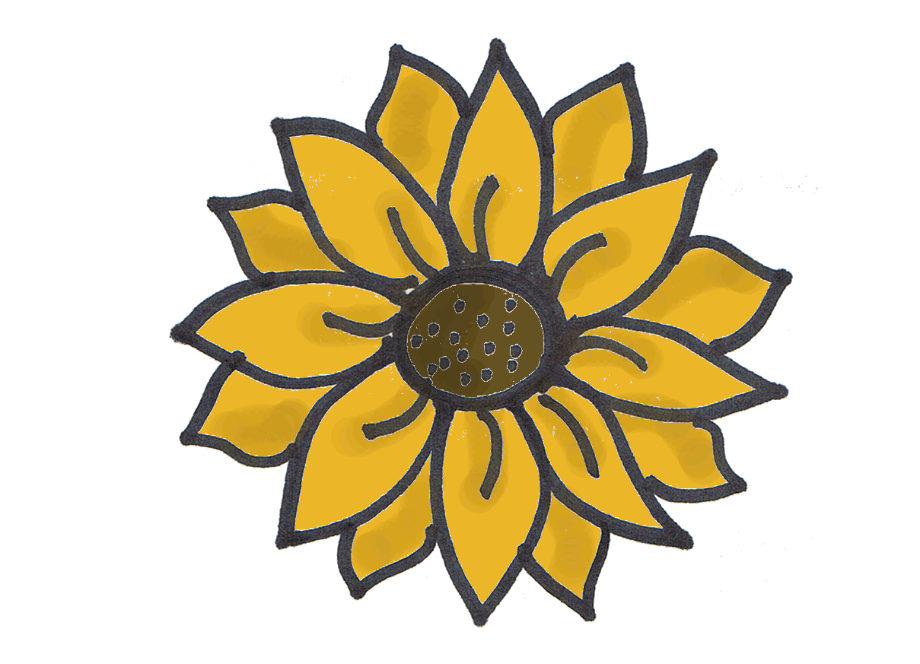
Now draw the second leaf behind the shoot, like so: (We are mostly seeing the back of the second leaf.) Then draw the veins of the leaf, and the shoot (or stem) of the flower. I love pencils for this tutorial because not only does it give great depth to the piece, but it’s also erasable! (That’s what I imagine to help myself illustrate the shape!) Keeping that in mind, go ahead and sketch the first leaf with your pencil. The first sunflower leaf in this tutorial looks a bit like a heart. Also add some shading behind the petals in the foreground! I tend to be heavier-handed with the petals toward the back of the petal structure.įinally, get in there with a finger and blend the pencil to make the shading look a bit more gradual and natural.Īnd voilà! 3. Scribble softly over the bases of the petals. Once you’ve stippled, dashed, and all that jazz, it’s time to shade again with the pencil. You can add small dashed lines around the tips of the petals for some extra pizzazz! Next, add lines emanating from the base of your petals to add detail and definition! Add lines to every petal, even if the petal sits more towards the back layers. Just continue to fill space with petals in no particular order. Sunflowers have tissue-paper-like petals that seem to overlap and layer infinitely. “Petal” to the MetalĪnd now we’re jumping straight into the petals! First, draw the initial layer of petals with adequate space between them, like so: Just like in the my other two flower tutorials, the lines shouldn’t be perfectly curved or straight. Then, add some little lines extending out from the border of the larger circle for a little extra detail!Īnd you’ve done it! You should take a moment to congratulate yourself because the sunflower’s center is the most intricate part of the tutorial. This adds even more dimension to the darker areas! Try to limit your stippling to the true center of the flower and the area around the outside of the larger circle. Next trace over most - but not all! - of those seeds with your black ink pen.Īdd stippling (remember, “stippling” means adding little dots with your pen) to the areas we previously shaded with pencil. Pencil in some of that empty space in the center to create more shadow and depth in the center! Sunflowers have rich, dark centers and the shaded graphite around the seeds gives us that effect. I find that leaving some space between them allows for nice shading opportunity! You don’t have to fill the whole center with densely-spaced seeds. You can achieve this by moving your pencil in a jagged movement, almost repeating a tiny letter ‘v’.Īdd some dashed lines in the outer ring and then shade them with your finger to smudge the graphite!Īdd some larger seeds extending to the outermost circle. Once the true center of the sunflower is filled with seeds, add some shading to the circle that you drew in the first step. Sunflower seeds tend to be much smaller in the center and enlarge as they move out toward the petals. I found that a more oblong shape gives the center the look of starburst-like seed structure. Next, draw a smaller circle within the first circle.īegin adding little circles to represent the seeds in the sunflower’s center. Notice my circle is not perfect - that’s the look you’re going for here! Begin by drawing an organic, loose circle about an inch and a half in diameter with a pencil. The first element of the sunflower you’ll want to start with is the center. Pencil of your choice (be sure you can use it to blend!)ġ.

However, the demand for a sunflower illustration tutorial was undeniable, so I put the pencil to paper and began! Let’s dive into how you, too, can create a floral masterpiece! I’ll admit it: I felt a bit intimidated by drawing this flower when it was requested by TPK readers via Instagram.
#Small sunflower drawing how to
This is the third and final installment of my How to Draw Flowers series! For links to the first two tutorials, see the bottom of this post.


 0 kommentar(er)
0 kommentar(er)
